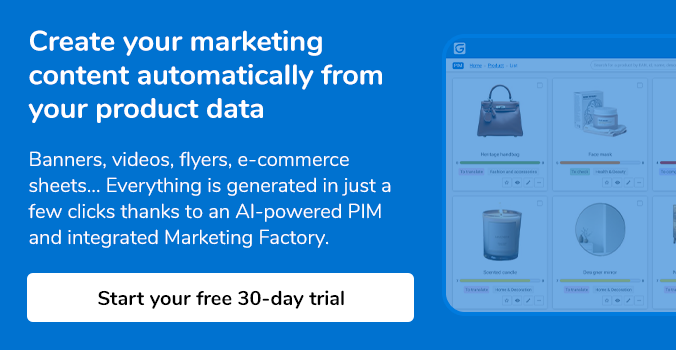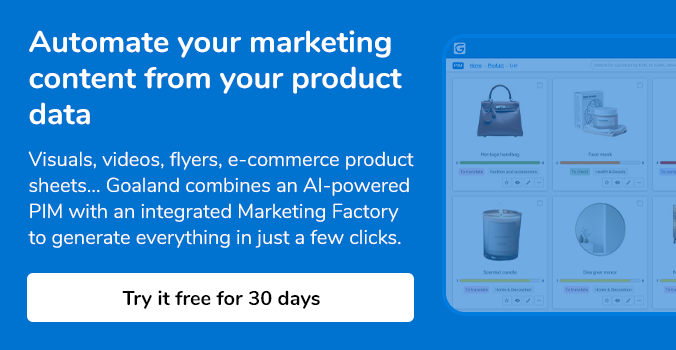The shopper's product experience is becoming an increasingly crucial part of any sales strategy: 84% of shoppers1 feel that it is as important as the products and/or services sold by a company.
For a business, this makes it essential to fully understand the needs of the shopper and to make constant efforts to provide them with the best possible product experience. To achieve this, it has become unavoidable to have a thorough knowledge of PXM. Product Experience Management (PXM) involves providing shoppers with the right information, at the right time and in the right place, to create a strong link between the shopper and the product and to persuade them to buy.
Discover the 5 vital pillars for handling your PXM perfectly and boosting sales.
#1. Remove any potential obstacles
For the best PXM, you must allow shoppers to make informed choices by providing them with as much information as possible before their purchase: sales pitch, marketing descriptions, technical information, user guides… If a business does not provide this information, the shopper may well change their mind: 98% of shoppers2 are discouraged from confirming their purchase if the product information is incomplete.

For example, a business should provide highly detailed information on the technical features of their product: size, weight, colors, materials, energy consumption… This information is vital to reassure the shopper that the product really corresponds to their needs and that it has the right features3.
#2. Create a strong link with the product
When a company uses a PXM process, they must enable shoppers to interact with their product and leave them with positive emotions throughout the customer journey.
In a physical store, handling a product can kindle positive emotions for the shopper and give them a sense of possession4 which makes them more likely to buy. In an on-line sales context, it's the product page that creates this link between the shopper and the product: it must enable them to imagine themselves using it.
To achieve this, the business must provide product pages containing a lot of digital media relating to the product: main image, tutorials, demo videos, 360° and 3D photos… It is essential to provide these elements to increase the shopper's desire to buy the product. For example, 360° photos which pivot virtually around a central axis appeal to shoppers and the associated products have a conversion rate 30%5 higher.
#3. Provide a consistent experience
#Provide consistent product information

To do PXM right, the product information on each shopping channel must be consistent.
With the rise in digital, 73% of shoppers6 now use all of the information sources available to research a product. In this omnichannel context, shoppers demand that information be consistent between the different communication channels: price, stock levels, technical features… It has become critical to present consistent information, at all times. In-store, 80% of shoppers7 use their Smartphone to check product information, customer reviews and prices for the products that interest them.
#Guarantee the consistency of product information
When choosing a PXM approach, it is essential to ensure the consistency of product information across all shopping channels.
Shoppers have specific expectations and want to access unique product information providing real added value during their customer experience. For example, shoppers using Instagram want to immerse themselves in the brand experience and visualize the product in real conditions of use.
To persuade potential shoppers on « Instagram Shopping , a business must be creative and adapt their product information to the specifics of each shopping channel: photos of the product in use, relevant hashtags, use of filters, addition of product tags… Adapting product pages to the specifics of Instagram Shopping is essential to attract and persuade users: 81% of shoppers8 research products with Instagram Shopping.
#4. Contextualize your product information
PXM imposes that businesses adapt their information to be coherent with the geographic location and the local shopping culture. This is important to provide a reassuring experience and to gain their trust.
To achieve this, a business must systematically translate all content into the language of their shoppers: over 70% of shoppers9 expect this. The business should also adapt their messages to the cultural specifics of each country: communication preferences, currencies, payment methods, navigation preferences… For example, shoppers in Australia like brands that go beyond simply « selling products » by promoting a lifestyle10. In answer to these communication expectations, the business must now also focus their efforts on « lifestyle marketing »11.
#5. Customization
For the best use of PXM, you should present shoppers with information adapted to their profile and related to their preferences.
When a business communicates impersonally they put a distance between their brand and the shopper leaving them with a sense of dissatisfaction: 74% of shoppers12 are frustrated when the information presented on a website is not customized and 42%12 are irritated by this lack of customization.
To turn this around, the company must provide a personalized experience for shoppers: 80% of them12 are more likely to buy after a brand has provided a customized experience.
Using PXM correctly involves a qualitative product approach which involves taking into consideration the specific desires of shoppers right across their customer journey. Adopting a PXM approach has become unavoidable and requires the use of high-quality Product Information Management solutions.
1
WAHID, N. W. (2020, august 25). 64 stats to build a business case for better digital experience. fullstory.com
2
Chrum, A.10 Stats That Prove the Importance of Product Content for E-commerce [Infographic]. onespace.com.
3
Gavriloff, J. G. (2021, february 26). Comment faire une fiche produit ? blog.hubspot.fr.
4
Williams, L. W., & Ackerman, J. A. (2011, december 15). Please Touch the Merchandise. hbr.org.
5
Bruiet, F.-P. (2019, april 30).En quoi des packshots de qualité impactent les conversions des sites e-commerce ?.
6
Harvard Business Review. (2017, january 3). A Study of 46,000 Shoppers Shows That Omnichannel Retailing Works.
7
Morgan, B. M. (2019, may 13). 40 Stats On Digital Transformation And Customer Experience.
8
Newberry, C. N. (2021, january 6). 44 Instagram Stats That Matter to Marketers in 2021. blog.hootsuite.com.
9
Sehl, K. S. (2019, january 23). 14 Tips for Building a Multilingual Social Media Presence. blog.hootsuite.com.
10
Coëffé, T. C. (2018, february 6). Les spécificités du e-commerce à l'international.blogdumoderateur.com.
11
Olenski, S. O. (2016, july 2). Can Your Content Sell A Lifestyle And Not Just Products? forbes.com
12
Morgan, B. M. (2020, february 18). 50 Stats Showing The Power Of Personalization. forbes.com. forbes.com







